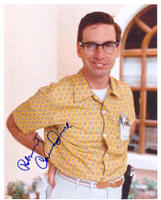
In the USA, the name John Doe is used for a defendant or victim in a legal example or for a person whose identity is unknown or is intended to be anonymous. Male corpses whose identity is unknown are also known by the name John Doe. A female who is not known is referred to as Jane Doe. A child whose identity is unknown is referred to as Precious Doe or Baby Doe. Additional people in the same family may be called James Doe, Judy Doe, etc.
An anonymous plaintiff is known as Richard Roe, or Jane Roe in the case of a woman.
The Oxford English Dictionary states that John Doe is "the name given to the fictitious lessee of the plaintiff, in the (now obsolete) mixed action of ejectment, the fictitious defendant being called Richard Roe".
An account of the reasons why a fictitious tenant and a fictitious defendant were named is found in Charles Rembar's book The Law of the Land.
By extension from the law usage, John Doe is often used in computer software needing a default or example first and last name for a form.
John Doe in various countries
Australia Fred Nurk, Joe Farnarkle, John Citizen
Austria Hans Meier, Hans Maier, Hans Mayer, Herr und Frau Österreicher
Argentina Juan Pérez, Fulano de Tal, Fulano, Mengano, Menganito.
Basque Country Iñaki, Patxi.
Belgium Jan Janssen, Piet Pietersen, Jos Joskens
Brazil Beltrano, Ciclano, Fulano, Zé ninguém, João da Silva, Zé da
Silva, João Ninguém, Maria Ninguém
Canada G. Raymond
China 陈小明 (Mandarin: Chen Xiao Ming / Cantonese: Chan Siu Ming), 某某(人)
(Pinyin: Mǒumǒu(rén)), lit. someone, sometimes used with surname of
the person
Colombia Fulano de Tal, Pepito Pérez;
Croatia Ivan Horvat, Pero Perić
Czech Republic Jan Novák, Karel Vomáčka
Denmark Morten Menigmand
Egypt Folan (arabic: فلان) (female equivalent: Folana, فلانة), Elan
(علان) as a partner.
Estonia Jaan Tamm, Tädi Maali
Faroe Islands Miðalhampamaður
Finland Matti Meikäläinen (male/generic) and Maija Meikäläinen (female)
France Jean Dupont, Paul Martin, Monsieur Durand
Germany Max and Erika Mustermann, Lieschen Müller, Otto
Normalverbraucher, Detlef Müller
Hungary Gipsz Jakab, Kovács János, Jóska Pista
Indonesia Si Polan
Iceland Meðal-Jón, Meðal-Jóna, Jón Jónsson, Jóna Jónsdóttir
India Ashok Kumar, (female equivalent unknown)
Republic of Ireland Seán and Síle Citizen
Israel Israel Israeli ישראל ישראלי and also Ploni פלוני and Almoni (as
a party to Ploni), Moshe Kohen משה כהן
Italy Mario Rossi, Tizio, Caio, Sempronio
Japan 山田太郎 (Yamada Taro), 山田花子 (Yamada Hanako), 名無しの権兵衛
(Nanashi-no-Gombei), 何野某(Nanno Nanigashi), (drowned corpses both
sexes, 土左衛門 Dozaemon)
Korea 홍길동 (Hong, Gil-dong)
Latvia Jānis Bērziņš
Lithuania Vardenis Pavardenis, Jonas Jonaitis, Petras Petraitis
Mexico Juan Pérez, Fulano de Tal, Mangano, Perengano, Zutano
Malaysia Si Anu, Si Polan, Si Polan Bin Si Polan
Malta Joe Borg
Netherlands a defendant is referred to with first name and initial,
e.g. "John D."; Jan Modaal is approximately the Joneses, in particular
referring to average wealth
Norway Ola and Kari Nordmann
Peru Juan Pérez, Fulano de Tal, Zutano, Mengano
Philippines Juan dela Cruz
Poland Jan Kowalski, Jan Nowak (but in legal/police work person unknown is NN)
Portugal Manuel Dos Santos, Zé Ninguém
Romania Xulescu, Cutare Cutărică
Russia Иванов (Ivanov), Петров-Сидоров (Petrov and Sidorov), Вася
Пупкин (Vasya Pupkin), Вася Тапочкин (Vasya Tapochkin)
Serbia and Montenegro Petar Petrovic
Slovakia Jožko Mrkvička
Slovenia Janez Novak
South Africa Koos van der Merwe
Spain Pepe Pérez, Pedro Pérez, Fulano, Fulanito, Mengano, Menganito,
Zutano, Zutanito
Sweden Kalle Svensson, Medelsvensson
Switzerland Herr und Frau Schweizer, Hans Meier, Hans Mustermann
Thailand Somchai, Sommai, Nai-Gor
Turkey Arparslan Türkeþ
United Kingdom Fred Bloggs or Joe Bloggs, John Smith
Uruguay Fulano, Mengano; Juan Perez
USA John Doe, Jane Doe, Precious Doe, Baby Doe, John Q. Public, John
Smith (which has largely been replaced with John Doe) The female
equivalent is Jane Doe or Mary Major. A second male suspect is dubbed
Richard Roe, and subsequent ones are referred to as John Stiles and
Richard Miles.
Vietnam Người dấu tên
 Several searches on "Graceland" finally led me to a fascinating American Art piece by Ann Marling, Elvis Presley's Graceland, or the Aesthetic of Rock'n'Roll Heaven. If you're even mildly interested in interior design, rock stardom, retro aesthetics, idol worship, Gone with the Wind, myth marketing, or The King, I highly recommend reading this article. It's outstanding.
Several searches on "Graceland" finally led me to a fascinating American Art piece by Ann Marling, Elvis Presley's Graceland, or the Aesthetic of Rock'n'Roll Heaven. If you're even mildly interested in interior design, rock stardom, retro aesthetics, idol worship, Gone with the Wind, myth marketing, or The King, I highly recommend reading this article. It's outstanding.











































 Add my feed to your Rss
Add my feed to your Rss
